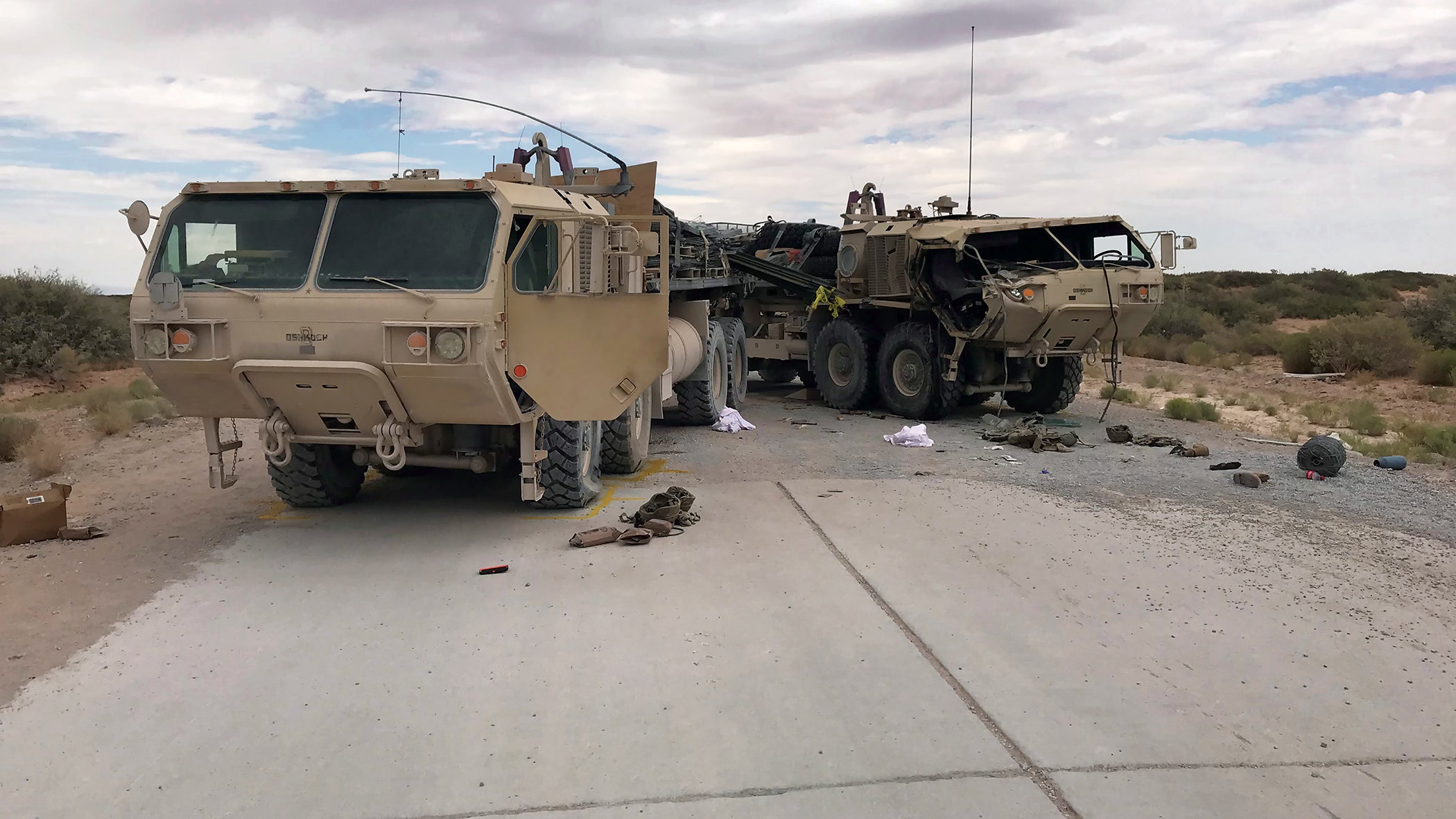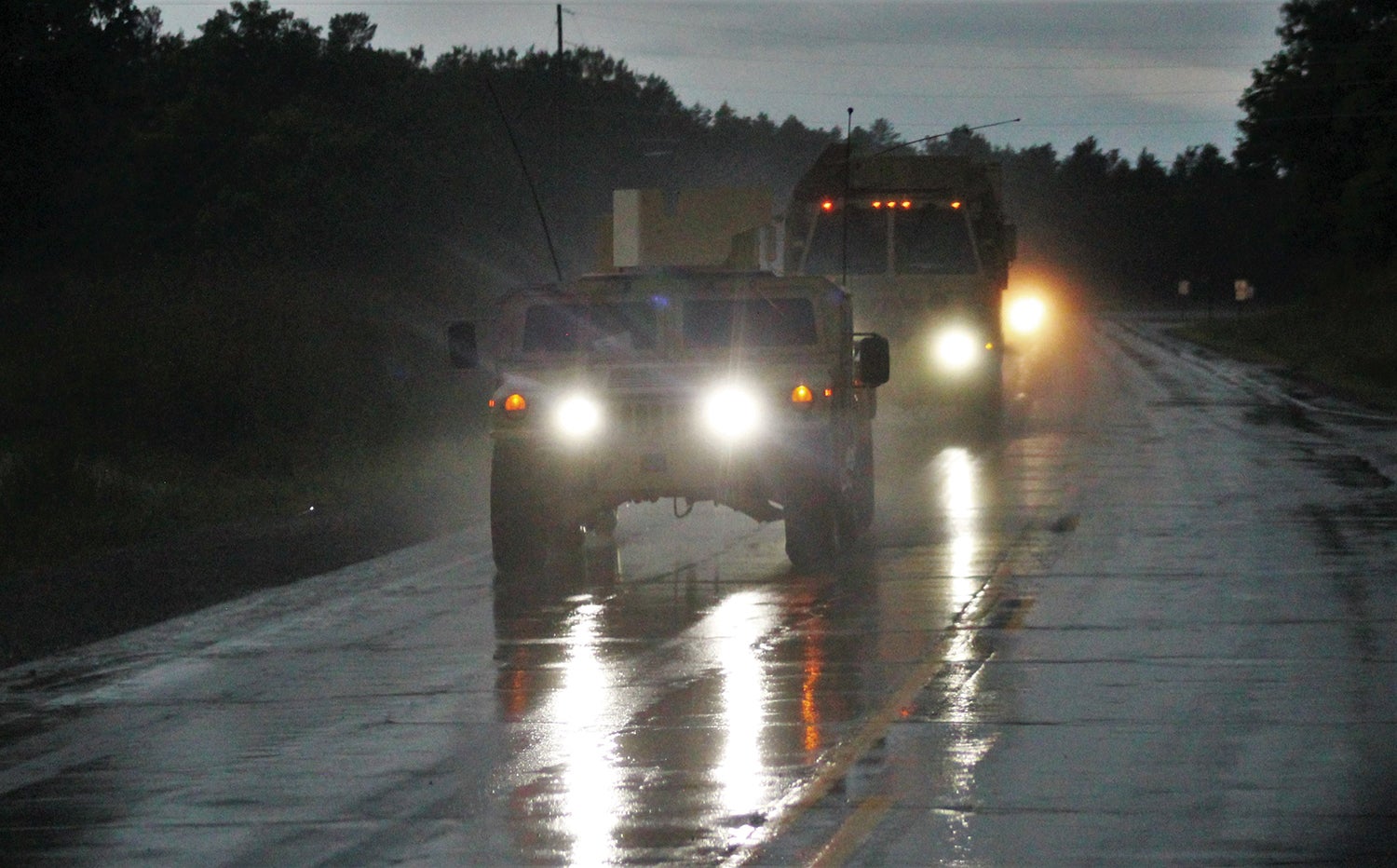A battalion was conducting a field training exercise in preparation for a combat training center rotation. The unit trained on tasks including brigade support area defense, displacement and reestablishment. The battalion commander ended the exercise on the sixth day, and the unit prepared to redeploy to the cantonment area.
The commander directed four M1120A4 trucks to make two convoy movements, both led by the transportation platoon leader. Without a convoy or movement briefing, the convoy made the first 90-minute movement to the cantonment area, dropped its cargo and returned to the brigade support area.
As the convoy made the second trip, using the same crews and vehicles, the third truck blew a tire. The driver slowed and pulled to the side of the road, but, due to limited visibility from heavy dust, the operator of the fourth truck did not see the vehicle in time to stop. Despite steering hard to the left, the fourth truck ran into the rear of the disabled vehicle, resulting in fatal injuries to the commander of the fourth vehicle.
Risk Factors
This scenario is a real-world mishap that mirrors many others investigated by the U.S. Army Combat Readiness Center (USACRC) at Fort Rucker, Alabama. Heavy dust limited visibility. Vehicles were not adequately spaced and traveled too fast for conditions. The unit driver training program did not include progressive training or convoy operations. Leaders did not properly conduct troop-leading procedures or convoy briefs, or practice dynamic risk management. The collision happened at the end of a long day on the last day of a field problem. Additionally, all four vehicles should have been deadlined by operator manual standards, and the convoy’s only communication was by personal cellphones.
This mishap started hours before the collision—and it happened in late spring, which has emerged as the Army’s riskiest time of year for tactical motor vehicle operations.

Deadly Mishaps
Tactical motor vehicle mishaps are the biggest killer of on-duty soldiers. Yearly statistics prove that these mishaps are deadlier than any other type, with 55 soldiers killed in the past five years alone. USACRC recently conducted a comprehensive, as yet unpublished, review of tactical vehicle mishaps since the beginning of fiscal 2015 and found key trends.
A majority of the study period’s tactical vehicle mishaps occurred during routine, uncontested, small-unit vehicle movements along roadways and trails, not cross-country or collective-level maneuver training. In other words, these mishaps happened while soldiers in single vehicles or small formations were simply driving from one location to another. Tragically, each mishap was preventable.
The Army safely conducts high-risk training and missions, including collective live-fires and airborne operations, every day. These signature events are likely decisive operations for the units conducting them, carefully planned, rehearsed and executed with significant consideration given to risk management. However, we are losing soldiers in supporting and shaping operations where relatively lower risk levels remain improperly mitigated.
Another noticeable trend is that cumulative fatal mishaps within the third quarter of each fiscal year were significantly higher than the other three quarters. More specifically, May and June accounted for 28% of fatal mishaps during the study period. In effect, nearly a third of the Army’s tactical vehicle mishaps are occurring over a mere 16% of the fiscal calendar annually.
There are a number of plausible theories for this “third-quarter spike.” This article will provide recommendations and share USACRC’s existing loss-prevention tools that leaders may employ to stop this trend. Experience proves that when leaders are aware of the hazards, they apply greater command emphasis to mitigate the risk.
Examine this problem, arrive at your own conclusions and become part of the solution.
Increased OPTEMPO
Several factors immediately come to mind when analyzing a recurring, almost seasonal, problem. USACRC’s first consideration was increased operational tempo (OPTEMPO). Many Army National Guard and U.S. Army Reserve units execute annual training during the third quarter. Unsurprisingly, these units account for 10% more third-quarter fatal mishaps (30%) than any other quarter. As OPTEMPO increases and more miles are driven, there is a corresponding rise in fatal accidents. However, this argument is more nuanced than it seems.
USACRC’s review of the Army’s annual total mileage determined that the third quarter is only the second-highest quarter for miles driven each year. The Army drives an average of 5 million more miles (80 million) in the fourth quarter than the third (75 million). Despite this increased OPTEMPO and corresponding elevation of risk exposure, the fourth quarter saw a 30% decrease in fatal vehicle mishaps during the study period. Greater exposure and OPTEMPO do not explain the spike as a whole. We must find and consider other factors.
Personal Distractions
USACRC also evaluated the effect of personnel turbulence during “PCS season.” Permanent change-of-station moves typically ramp up each June, when an average of nearly 9,000 soldiers report to new duty locations.
A summer-heavy personnel transition cycle makes sense. It’s easier on families, allowing children to complete the school year before moving, and presents an opportunity for soldiers to take leave during favorable weather in conjunction with relocation. However, similar to all operational transitions, personnel transitions, particularly those of leaders at all echelons, present risk that must be carefully managed.
The Army’s junior and midgrade NCOs are at the tip of the spear and critical to successful execution of motor vehicle operations. It is their responsibility to conduct troop-leading procedures for small-unit missions and enable success. However, it is not uncommon for NCOs to depart an assignment or position without their replacement in place. Often, a junior NCO is required to serve as an “acting” leader until a permanent replacement arrives.

We must place the same level of emphasis on these NCO transitions as a change of command, or we assume more risk. Without a managed transition between two leaders, we are not only missing an opportunity to transfer established standing operating procedures, but also individual soldier details such as driver certifications and performance history.
Failures in Leadership
Leaders not enforcing standards, not conducting rehearsals or convoy briefings, or not conducting proper troop-leading procedures contribute in some form to more than 70% of catastrophic vehicle mishaps annually. Therefore, those NCOs serving in an acting capacity require even more attention and oversight, and we must set conditions for success by certifying them to perform enhanced leadership tasks. Deliberate transition plans concluding with an outbrief two echelons up are a good start to reducing the risk profile associated with personnel turbulence.
Inadequate driver training programs continue to factor into most Army tactical motor vehicle mishaps. More than 80% of USACRC investigations identify issues with driver training and/or absence of proper qualifications documentation. When drivers are not trained to standard and increase their miles driven, the risk profile is enlarged.
The September 2019 update to Army Regulation (AR) 600-55: The Army Driver and Operator Standardization Program sets clear standards for effective driver training programs to reduce mishaps. Among other changes, it establishes a progressive training model that ensures drivers are fully— not just minimally—qualified to operate their assigned vehicles.
Likewise, fatigue almost certainly plays a role. At least 30% of soldiers directly involved in third-quarter tactical vehicle mishaps during the study period were on duty for over 12 hours. Longer daylight periods sometimes push limited visibility training further into the day.
Unmitigated, this places additional strain on soldiers awake since dawn. Given that most tactical vehicle mishaps occur during routine, uncontested movements on roadways, fatigue is a likely contributor to inattention, complacency and haste.
Accident Reduction
So, how do we prevent a third-quarter spike not only this year, but in years to come? There are four key actions to overcoming this trend:
- Commanders must be involved in their driver training program—commander involvement is foundational to the Army’s collective training and operations. The recent update to AR 600-55 requires commanders to interview, select and train their unit’s drivers. Driver selection is one of a company commander’s most important duties, and applying rigor to the selection process of both drivers and vehicle commanders will prevent mishaps. Battalion command teams must validate their programs, ensuring the programs are progressive in nature to prepare drivers for expected operational conditions, not just paved roadways. Brigade command teams should verify unit compliance with AR 600-55 and refine as necessary (Appendix J to AR 600-55 is a useful checklist).
- Junior leaders must be trained as vehicle and serial leaders. Proper execution of troop-leading procedures in movement planning and execution is risk management. Good procedures result in identified hazards, conduct of multiple rehearsals, identification of unserviceable equipment and other actions that increase safety. Great units create leader-development opportunities and programs to ensure junior leaders have the needed tools to succeed.
- Dynamic risk management must be emphasized and discussed throughout operations, especially those lasting beyond a few hours. Leaders tend to do their best risk management when planning major operations. They develop and discuss deliberate (and lengthy) risk assessment worksheets during execution of troop-leading procedures. However, the further they get from their final rehearsal, environmental changes, soldier fatigue and materiel issues increasingly factor into operations. Leaders must understand and appreciate the need for holistic risk assessment as conditions change and different forms of fatigue set in. Start by asking, “What has changed, and what are the three most dangerous things we are about to do?”
- Knowledgeable leaders must be present where the risk is. Battalion commanders and command sergeants major are almost never eyewitnesses to mishaps. It is also rare for company commanders or first sergeants to witness mishaps. Why? They have the knowledge, experience and authority to stop mishaps before they happen. But obviously, command teams cannot be everywhere. All junior leaders should have the authority to stop unsafe acts. While experience will come with practice and repetition, leader certification programs will provide them with the knowledge to know what right looks like. Junior leaders are the crucial link to tactical vehicle safety.
USACRC has multiple tools available to help soldiers and leaders prevent these and other mishaps. The Joint Risk Assessment Tool, Army Readiness Assessment Program and Driver’s Training Toolbox, all available at https://safety.army.mil, are long-standing products proven to help reduce risk at every level.
The center also recently added Small Unit Leader Cards to its repository, which are designed to be a quick reference for junior leaders making the real-time decisions described above.
While there are many more tools available on our website, USACRC’s most valuable resource is its people. USACRC stands ready to assist commanders in the field. Reach out if you need support or have successful programs and processes we can share. Saving lives is a team effort, and USACRC is part of your team.
* * *
Brig. Gen. Andrew Hilmes is commanding general of the U.S. Army Combat Readiness Center, Fort Rucker, Alabama, and director of Army Safety. Previously, he was deputy commanding officer-maneuver, 3rd Infantry Division, Fort Stewart, Georgia, and before that, he was executive officer to the commander of U.S. forces in Operation Resolute Support, Afghanistan. He earned his commission as an armor officer at the U.S. Military Academy, West Point, New York, graduating in 1995.

